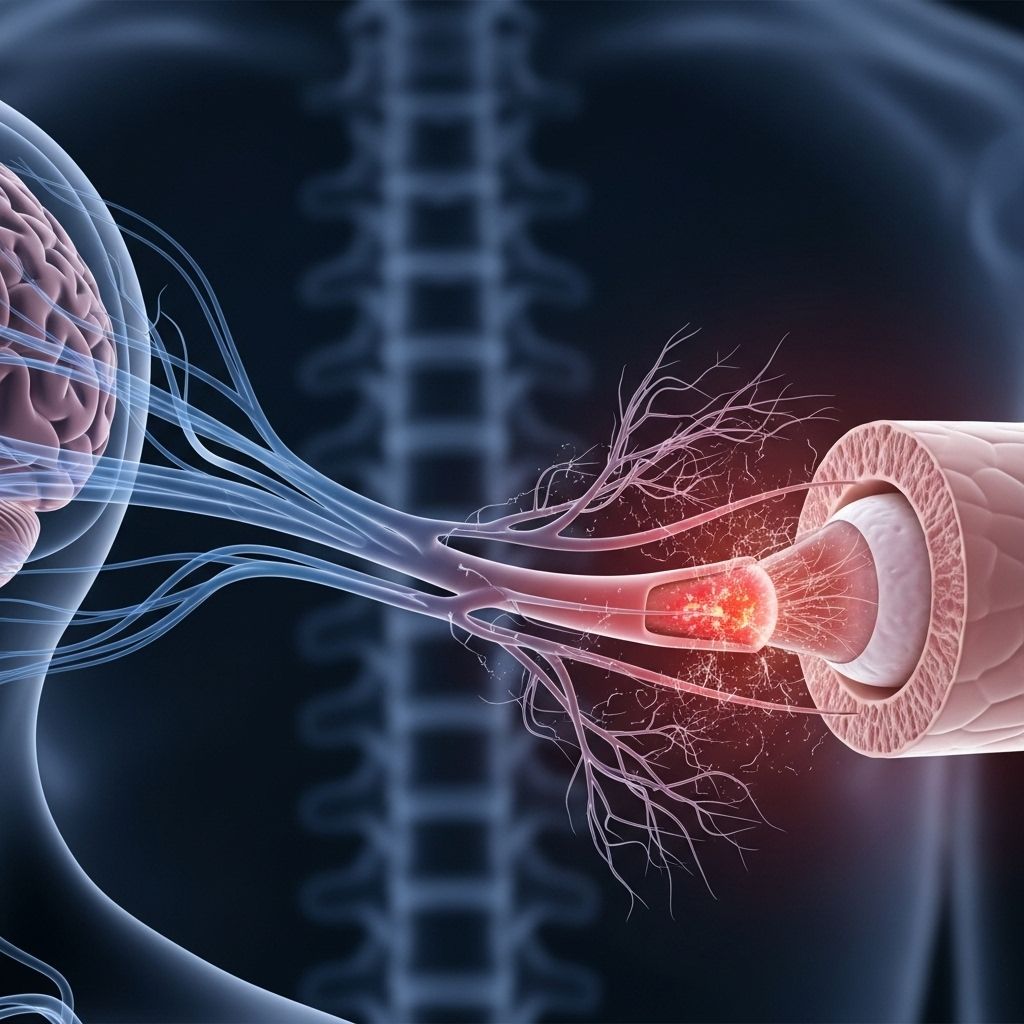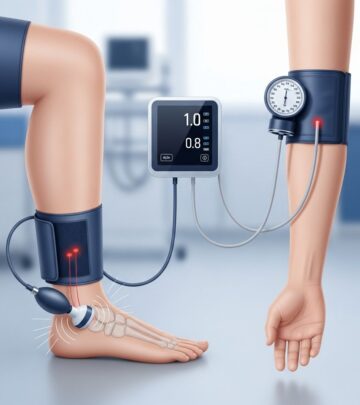Neuromyelitis Optica: Symptoms, Causes, and Impacts
Understanding neuromyelitis optica, a rare autoimmune disorder impacting the optic nerves and spinal cord, with details on symptoms, causes, and outlook.

Overview
Neuromyelitis optica (NMO), also known as neuromyelitis optica spectrum disorder (NMOSD) and sometimes referred to as Devic disease, is a rare autoimmune condition of the central nervous system. It primarily causes inflammation and damage to the optic nerves (connecting the retina of the eye to the brain) and the spinal cord, although less frequently it may also involve portions of the brain.
This disorder occurs when the immune system mistakenly attacks the body’s own nerve cells, specifically targeting proteins in the central nervous system. The result is significant nerve damage that can lead to vision loss, weakness or paralysis, sensory changes, and other neurological symptoms. NMO predominately affects the optic nerves and spinal cord, which differentiates it from multiple sclerosis (MS).
Key Points
- NMO is an autoimmune disorder characterized by inflammation of the optic nerves and spinal cord.
- Commonly misdiagnosed as multiple sclerosis, but NMO is a distinct condition with unique features.
- Symptoms include vision loss, paralysis, pain, and other dysfunctions in the body’s sensory and motor responses.
Symptoms
The symptoms of neuromyelitis optica arise from inflammation in the optic nerves and spinal cord. The progression and severity can vary, and symptoms may improve or worsen in bouts known as relapses. Over time, repeated attacks can cause lasting disability.
Vision-Related Symptoms (Optic Neuritis)
- Blurred vision or complete vision loss in one or both eyes
- Loss of color perception (colors appear faded)
- Eye pain, especially with movement of the eye
Spinal Cord-Related Symptoms (Transverse Myelitis)
- Stiffness, weakness, or numbness in the legs, and occasionally in the arms
- Loss of sensation in arms or legs
- Paralysis: partial or complete loss of movement
- Bladder and bowel dysfunction: including difficulty emptying the bladder, incontinence, and constipation
- Tingling or shooting pains in the neck, back, or abdomen
Other Symptoms
- Persistent hiccups
- Nausea and vomiting
- In severe cases (especially in children): confusion, seizures, or coma
Symptoms may remit (improve) and then relapse (worsen) over time. Each relapse has the potential to inflict more damage, increasing the risk of blindness or permanent paralysis.
Causes
Neuromyelitis optica is an autoimmune disorder. While the exact mechanism is not entirely understood, the disease develops when the immune system produces antibodies that mistakenly target proteins in the central nervous system. This triggers inflammation, primarily in the optic nerves and spinal cord, though sometimes in the brain.
- NMO may be triggered by a prior infection or develop in association with other autoimmune diseases.
- The most commonly implicated autoantibody is aquaporin-4 antibody (AQP4-IgG), which targets water channels in the nervous system.
- Other similar disorders, such as myelin oligodendrocyte glycoprotein antibody-associated disease (MOGAD), may share features but affect different proteins.
Irregular antibodies cause damage to the protective coating (myelin) of nerve fibers, resulting in loss of function. The disease process is different from MS, which is a more diffuse and progressive autoimmune disorder affecting the brain and spinal cord.
Risk Factors
The exact risk factors for neuromyelitis optica are not completely defined, but certain populations appear to be more at risk:
- Gender: Women are affected more frequently than men.
- Ethnicity: Higher rates are reported among people of African, Asian, and Latin American descent.
- Age: It most commonly appears in adults but can occur at any age, including children.
- Having other autoimmune conditions may increase susceptibility.
Complications
If not properly managed, NMO can lead to significant health consequences and lasting disability. Complications include:
- Permanent loss of vision (blindness) in one or both eyes
- Paralysis or severe weakness in arms and legs
- Painful muscle spasms
- Persistent numbness or loss of feeling
- Bladder and bowel dysfunction: increased risk of infections and skin problems
- In children, permanent neurological deficits such as difficulty reasoning, seizures, or coma may occur
Each relapse threatens further irreversible damage, making prompt treatment and prevention of attacks critical.
Similar Conditions
| Condition | Main Features | Key Differences |
|---|---|---|
| Neuromyelitis Optica (NMO) | Autoimmune attacks targeting optic nerves and spinal cord. Relapses common. | Primarily affects optic nerves and spinal cord; distinct antibody (AQP4). |
| Multiple Sclerosis (MS) | Widespread inflammation in CNS with plaques/lesions. Progresses diffusely. | Affects brain, optic nerves, spinal cord; multiple types of lesions; slower course. |
| Myelin Oligodendrocyte Glycoprotein Antibody-associated Disease (MOGAD) | Similar attacks in optic nerve, spinal cord, and brain. Usually better recovery. | Involves MOG antibodies; different response to treatment. |
Diagnosis
Accurate diagnosis of neuromyelitis optica is essential, since misdiagnosis may affect treatment and outcomes. Clinical evaluation may include:
- Detailed medical history and neurological exam
- MRI imaging of the brain, optic nerves, and spinal cord to detect inflammation or lesions
- Blood tests for AQP4 and MOG antibodies
- Other tests to rule out infections and assess immune system function
Distinguishing NMO from MS and other demyelinating diseases is crucial for directing the appropriate therapy.
Treatment
NMO cannot be cured, but early and effective treatment can reduce the severity and frequency of attacks, limit disability, and improve quality of life.
- Acute attacks: Treated with high-dose corticosteroids to reduce inflammation. Plasma exchange (plasmapheresis) may be used in severe cases.
- Long-term management: Immunosuppressive medications (such as rituximab, azathioprine, mycophenolate) to prevent relapses.
- Supportive care: Rehabilitation, pain management, and physical therapy for ongoing symptoms.
- Management of bladder, bowel, and motor complications as needed.
Prevention of further relapses is critical, since each episode can result in additional, potentially irreversible damage.
Outlook and Impact on Life
NMO often follows a relapsing-remitting pattern rather than steady progression. While some attacks may be reversible, others can result in permanent visual or motor loss. The impact on daily living depends on the frequency and severity of relapses. Timely diagnosis and consistent therapy with immunosuppressive agents help improve the long-term outlook and reduce the risk of major disability.
Living with Neuromyelitis Optica
- Patients may require ongoing physical therapy or occupational therapy.
- Visual aids and accessibility modifications may be needed if vision loss occurs.
- Health professionals often recommend routine monitoring and regular follow-up.
Frequently Asked Questions (FAQs)
Q: How is neuromyelitis optica different from multiple sclerosis?
A: NMO primarily affects the optic nerves and spinal cord. Its attacks are mediated by distinct antibodies and, although it shares some symptoms with MS, the frequency and severity of relapses, as well as the response to certain medications, are different.
Q: Is neuromyelitis optica curable?
A: There is currently no cure for NMO, but treatment can induce long-term remission and prevent relapses. Immunotherapy and supportive care are key to managing the disease.
Q: What triggers NMO relapses?
A: Triggers are not always clear, but relapses may follow infections, stress, or changes in immune activity. Maintaining regular treatment reduces relapse risk.
Q: Can children get neuromyelitis optica?
A: Yes, children can develop NMO and may experience additional symptoms like confusion, seizures, or coma. Symptoms in children may overlap with MOGAD.
Q: What is the outlook for people with NMO?
A: Prognosis varies. Some people experience only one attack, while others face frequent relapses, which can be disabling. With ongoing treatment, many patients stabilize and avoid severe complications.
Conclusion
Neuromyelitis optica is a rare yet potentially disabling autoimmune disorder. Its primary symptoms—vision loss, pain, paralysis, and sensory changes—result from immune attacks on the optic nerves and spinal cord. Early identification, accurate diagnosis, and prompt treatment are crucial for minimizing disability and maximizing quality of life. Ongoing research continues to refine therapies and improve outcomes for those affected by neuromyelitis optica.
Read full bio of Sneha Tete












